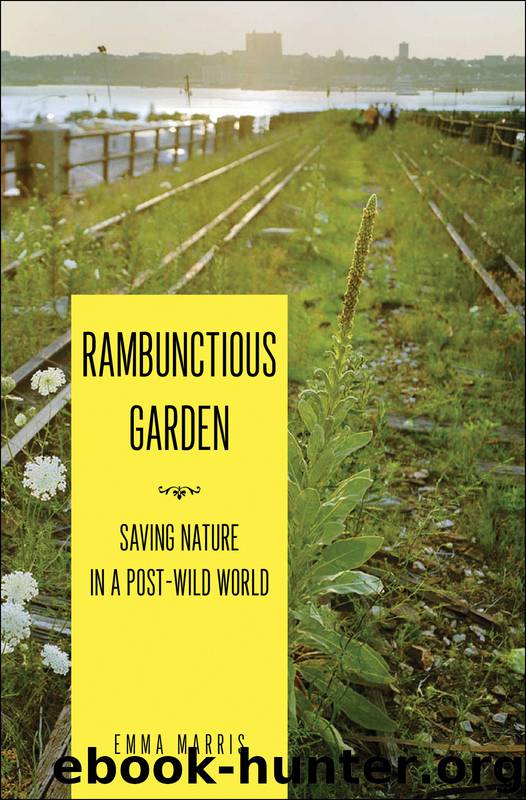Rambunctious Garden by Emma Marris

Author:Emma Marris
Language: eng
Format: epub
Publisher: Bloomsbury Publishing
7 | Novel Ecosystems
Ascension Island in the South Atlantic is famous among ecologists. Usually they tell tales about single aggressive invader species bulldozing complex ecosystems. Here it was the other way around. Ascension started out as a monotonous plain of ferns; a visiting Darwin dismissed it in July 1836 as “very far inferior” to nearby St. Helena. Seven years later botanist Joseph Hooker recommended the island be improved by the importation of many new kinds of plants—what modern ecologists might see as a massive invasion. But this invasion resulted not in ecological meltdown but in the creation of a cloud forest composed of species from here and there, trapping mists, cycling nutrients, and surviving, generation after generation, all without having evolved together.1
According to ecology textbooks, millennia of coevolution are required to set up complex interactions between plants, animals, microorganisms, nutrients, water, and other components of ecosystems. The idea that a bunch of random plants from hither and yon could convincingly impersonate a real ecosystem rather than collapse into species-poor and poorly functioning wastelands has been markedly hard to swallow.
No one knows this better than Joe Mascaro, the graduate student who went with me to visit Ostertag and Cordell’s weeded forest plots in Hawaii. Just a few years ago Mascaro was hacking down “invasive” trees in his mother’s backyard, fully on board with the conventional values of ecology. Now he’s learned to appreciate novel ecosystems:2 new, human-influenced combinations of species that can function as well or better than native ecosystems and provide for humans with ecosystem services of various kinds—from water filtration and carbon sequestration to habitat for rare species. Sometimes the exotic components of these ecosystems have considerable cultural value as well.
Mascaro took me on a tour of several novel ecosystems that he studies on the Big Island. He has his sites to himself, as other ecologists consider them trashy places not worth studying. Mascaro told me about the weird things he’d found in the neglected novel forests—barrels, wire, car parts, and whole burned-out cars—trash in trashy ecosystems.
One novel forest he studies is dominated by pinelike Australian ironwood. The canopy is dense, and there is little undergrowth, apart from some sword ferns from India, trumpet tree from the American tropics, and a sprinkling of other species. Underfoot, shed ironwood “needles” gives the turf a pleasant bounce. “This soil development is a service you can get from exotics,” says Mascaro, scuffing at it with his foot. On the way out he indicates a single silk oak, another Australian species.
I saw more ironwoods, tiny ones this time, at a site that dates from 1960, when a lava flow created new beachfront land. Before humans came to the islands, the first species out on new flows was always the Hawaiian tree with silky red stamens, ‘ōhi‘a. Today the autograph tree from tropical America (so called because one can write on the leaves by scraping off the green cuticle) and small Australian ironwoods were colonizing this flow. The interesting result is that no one can properly say that the autograph trees and ironwoods “invaded” the site.
Download
This site does not store any files on its server. We only index and link to content provided by other sites. Please contact the content providers to delete copyright contents if any and email us, we'll remove relevant links or contents immediately.
Sapiens: A Brief History of Humankind by Yuval Noah Harari(13114)
The Tidewater Tales by John Barth(12045)
Do No Harm Stories of Life, Death and Brain Surgery by Henry Marsh(6349)
Mastermind: How to Think Like Sherlock Holmes by Maria Konnikova(6271)
The Thirst by Nesbo Jo(5819)
Why We Sleep: Unlocking the Power of Sleep and Dreams by Matthew Walker(5678)
Sapiens by Yuval Noah Harari(4574)
Life 3.0: Being Human in the Age of Artificial Intelligence by Tegmark Max(4536)
The Longevity Diet by Valter Longo(4464)
The Rules Do Not Apply by Ariel Levy(3931)
The Body: A Guide for Occupants by Bill Bryson(3853)
The Immortal Life of Henrietta Lacks by Rebecca Skloot(3841)
Why We Sleep by Matthew Walker(3796)
Animal Frequency by Melissa Alvarez(3770)
Yoga Anatomy by Kaminoff Leslie(3724)
Barron's AP Biology by Goldberg M.S. Deborah T(3643)
The Hacking of the American Mind by Robert H. Lustig(3597)
All Creatures Great and Small by James Herriot(3540)
Yoga Anatomy by Leslie Kaminoff & Amy Matthews(3419)
